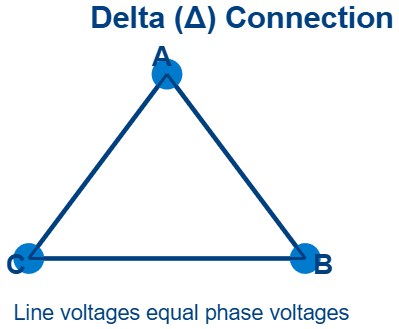What Are Delta (Δ) and Wye (Y) Connections in Three-Phase Power?
In electrical engineering, especially in industrial settings, three-phase power is the standard for distributing large amounts of electricity. It’s more efficient than single-phase systems and supports heavy loads better. But when we talk about three-phase power, we often hear two terms thrown around: Delta (Δ) and Wye (Y) configurations.
Let’s break down what these are, where they’re used, and how to calculate voltages and currents in both systems.
Delta (Δ) Connection — The Triangle Setup
In a Delta connection, the three components (resistors, windings, or loads) are connected end-to-end in a closed loop that forms a triangle or “Δ” shape. Here, line voltage = phase voltage.
Each line is connected at the junction of two loads.
Key Properties of Delta:
- Line voltage = Phase voltage
- Line current = √3 × Phase current
- No neutral wire required
- Suitable for high-power transmission
- Motors are often Delta-connected at startup for torque advantages
Wye (Y) Connection — The Star Setup
In a Wye connection (also called Star connection), one end of each load connects at a central point — the neutral — forming a “Y” shape.
Key Properties of Wye:
- Line voltage = √3 × Phase voltage
- Line current = Phase current
- Neutral wire is present
- Common in distribution systems (especially residential)
- Better voltage stability for unbalanced loads
Visual Representation
You can picture it like this:
Delta (Δ):

Wye (Y):

In Delta, everything forms a loop. In Wye, all points meet at a neutral node (N).
Voltage & Current Relationships
In Wye (Y):
- Line Voltage (V<sub>L) and Phase Voltage (V<sub>ph):

- Line Current = Phase Current
In Delta (Δ):
- Line Voltage = Phase Voltage
- Line Current (I<sub>L) and Phase Current (I<sub>ph):

Practical Differences
| Feature | Delta (Δ) | Wye (Y) |
|---|---|---|
| Neutral wire | No | Yes |
| Voltage Stability | Poor in unbalanced load | Good |
| Current Distribution | More current in lines | Less current |
| Common Use | Motors, industrial | Homes, light loads |
Example 1: Basic Wye Voltage Calculation (Beginner)
Problem:
A three-phase Wye-connected system has a phase voltage of 220 V. What is the line voltage?
Solution:
Use the formula:

Answer: Line voltage is approximately 381 V
Example 2: Delta Current Calculation (Intermediate)
Problem:
In a Delta-connected motor, the phase current is 5 A. What is the line current?
Solution:
Use the Delta current formula:

Answer: Line current is approximately 8.66 A
Example 3: Power in a Delta System (Advanced)
Problem:
A three-phase Delta-connected load has:
- Line voltage: 400 V
- Line current: 10 A
- Power factor: 0.9
Find the total power consumed.
Solution:
Use the three-phase power formula:

Answer: The power consumed is 62.35 kW
Choosing Between Delta and Wye — When and Why?
- Delta Systems are typically used where:
- High starting torque is needed (like motors)
- System needs to run without neutral
- Phase failure needs to be tolerated temporarily
- Wye Systems are chosen for:
- Residential and commercial power distribution
- Loads that require neutral (like lighting or computers)
- Balanced voltage across each load
Final Thoughts
Understanding the Delta and Wye configurations is essential for anyone working with three-phase systems. Whether you’re sizing transformers, analyzing loads, or designing motors — these fundamentals are critical.
Here’s a quick recap:
- Delta: Line voltage = phase voltage, but line current is √3 times the phase current.
- Wye: Line current = phase current, but line voltage is √3 times the phase voltage.
- Always consider power factor when calculating power in any three-phase setup.

Leave a Reply